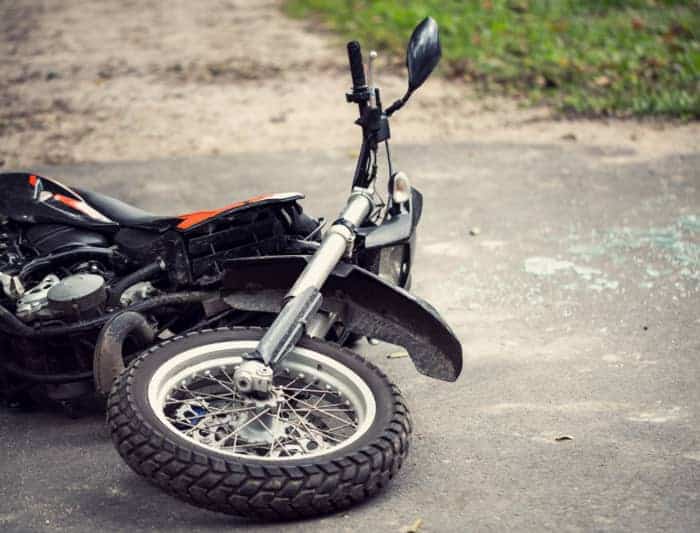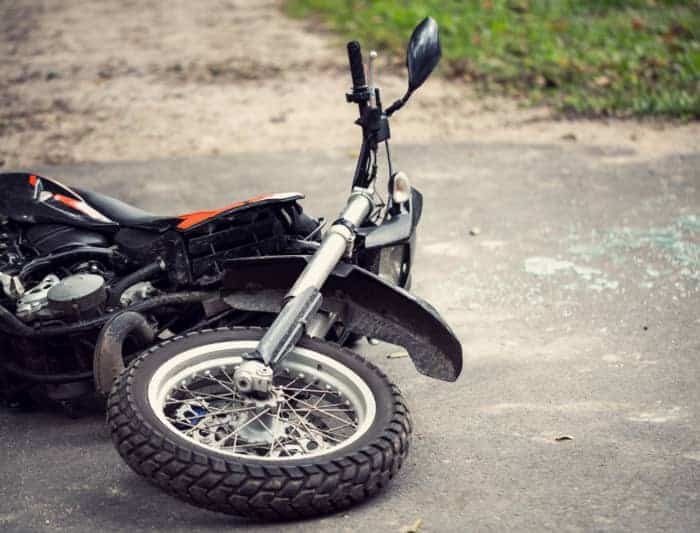
Generally, motorcycles sit on a tiny little kick stand on the left side, and knocking it over can be really easy. Maybe your motorcycle is outside and the wind pushes it, or it’s in the garage and you accidentally bump it on your way out the door.
Either way, when your motorcycle gets knocked over, you might have bigger issues than just some scratched paint or bent brake levers. It’s not uncommon for a motorcycle to struggle turning over when it has just been knocked down.
Why won’t a motorcycle start after falling over? If a motorcycle won’t start after falling over, the biggest reason may be due to fuel delivery issues such as too much fuel leaking into the engine cylinders. The motorcycle may also have an internal switch that has malfunctioned or have a disconnection in the electronics because of the fall.
The only thing more embarrassing than having your bike knocked over is not being able to start it after it falls. Although there’s no way to fool proof a motorcycle to make sure it doesn’t fall over, we can take a look at a couple ways to make sure that yours stays upright as well as go into depth of why a it may not start if it falls and how you can fix it after it does.
Reasons Your Motorcycle Won’t Start After Falling Over
I’m sure that none of us want it to happen, but having your motorcycle fall over is only a question of when, meaning if you haven’t knocked it over yet, it’s really only a matter of time. To look at the reasons why a motorcycle won’t start, we will begin by looking at the most common causes.
The most common reason a motorcycle won’t start after falling is because of fuel delivery problems. This is going to be directly targeted at carbureted bike designs. As you all may know, the way a carbureted bike works is through getting gravity fed from the tank to the carburetor, and then from the carburetor it goes directly into the cylinders.
When a motorcycle is knocked over and fuel is sloshed around, sometimes too much fuel can be fed from the carburetor into the engine cylinders. If too much fuel goes into any of the cylinders, the spark plug may have difficulty sparking because the connections on it are too wet from the gasoline.
The reason this won’t happen to a fuel injected motor is because fuel is delivered and regulated by the computer. So, whether it was knocked over or not, the computer has to signal fuel to be delivered before it enters the cylinders.
Other than having a flooded cylinder, another common reason a motorcycle won’t start is because of an internal switch that has malfunctioned. There are a lot of sensors on a bike, and the newer the bike, the more sensors you’re going to find.
On newer motorcycles, they have kill switches that detect whether it is standing up straight or lying of the ground. These switches are around so that if you are in an accident, or the bike falls while it is running and in gear, it’s not going to continue to run and possibly damage another motorist. The kill switch is there as a safety net for the motorcycle, and if triggered, won’t allow it to restart until the switch is reset and the bike is upright.
Finally, a no-start condition could be brought on by some disconnection in your motorcycle electronics if it is dropped. There’s a lot of connections in a motorcycle that are needed in order for it to turn over. A major one is the connection that is made to the battery. On older bikes, or bikes that are kept outside, corrosion on battery terminals are normal, but should be regularly cleaned off.
If corrosion on a battery becomes severe enough, the connection that is made on it can become fragile. When a bike with a bad battery connection falls over, it wouldn’t be surprising if the impact caused the connection to shake loose. So, in a condition where you don’t think it’s your fueling and/or the kill switch, check the connection that your motorcycle has to the battery.
How To Fix A Motorcycle That Won’t Start After Falling Over
So let’s say that you knocked your motorcycle over and it won’t start, what do you do next? Sometimes bikes fall over in the least convenient spots, but luckily, getting your bike going again shouldn’t be too difficult.
First, let’s look at how to fix your motorcycle if you suspect one of the cylinders is flooded. Like I mentioned earlier, it’s common to have a cylinder become flooded if your motorcycle is tipped over and it takes you a few minutes to bring it back up right. The best way to go about this is removing your spark plugs, drying them off, and then putting them back in the bike. This is a really effective way, but what if the spark plugs are really hard to reach?
If you can’t get to the sparkplugs, the best way to get your bike to start up is by trying to have it turn over with your hand on wide open throttle. At wide open throttle you have the most air possible entering the system. Since there is a lot of fuel, it will take a lot of air to create a good enough mixture to combust.
Doing this might take a few tries, so be careful with your starter. After every start attempt, let everything cool for a minute or two so that you don’t damage anything. Once it starts up, slowly release the throttle. It might take a little bit until all the extra fuel is burned up, so don’t just release the throttle as soon as it turns over.
Like I mentioned already, a sensor on your motorcycle may have been notified that your bike tipped and needs to be reset before it lets you start it up again. Usually all it takes to reset this trigger is power cycling the bike.
That means turning the bike off all the way and taking the key out, and letting it sit for just a minute or two. After that, the switch should be reset and allow you to start the bike up. If you still are having trouble starting, then that means there is something else on the motorcycle that is the underlying issue.
How To Prevent Your Motorcycle From Falling Over Again
It’s impossible to prevent all fall-over scenarios, but it’s important that we do what we can to so that we don’t have any silly mistakes. First, make sure that your motorcycle is parked somewhere that is visible, but out of the way of heavy traffic.
That goes for whether you’re parked outside or in a garage or outside of a store or park. Find a place to put it that is out of the way of nearby foot pedestrians and cars. If you park it in a parking spot make sure that cars who are in the area can see it.
You don’t want them pulling into a spot only to see your bike too late and knocking it over, or having a car next to it open it’s doors and knocking it off balance. It may be helpful placing a bright colored flat somewhere to help people notice it more.
Another common way your motorcycle can fall, other than when it’s parked, is when you come to a stop. Sometimes stoplights are on steep hills or bends in the road, or even in a construction zone. Always be aware of where you are coming to a stop. Is the ground flat? Is there loose gravel under your feet? Always do what you can to be aware so that you don’t set your bike right down onto the ground.
See our other article by clicking here if you’re wondering how to properly ride a motorcycle uphill that can help prevent a fall.
Is It Bad For The Motorcycle When It’s Dropped?
You never want to have your motorcycle fall on its side. Will it completely ruin the bike? No, it’s usually fine after a fall, but as soon as your bike falls, you might lose a lot of resale value, not to mention it just makes your bike look like you don’t take very good care of it.
Your biggest concern will likely be cosmetic issues which is something you’ll probably be able to fix yourself. Check out our other article here to learn more about what happens when a motorcycle tips over, how long is too long to keep it on it’s side, and what to do when it does tip over. Bikes are heavy, and easier to tip over than you might think, so be careful and have fun!

